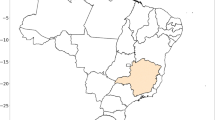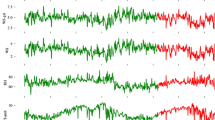Abstract
In this article, the linear genetic programming (LGP) is utilized to predict the solar global radiation. The solar radiation is formulated in terms of several climatological and meteorological parameters. Comprehensive databases containing monthly data collected for 6 years (1995–2000) in two nominal cities in Iran are used to develop LGP-based models. Separate models are established for each city. To verify the performance of the proposed models, they are applied to estimate the solar global radiation of test data of database. The contribution of the parameters affecting the solar radiation is evaluated through a sensitivity analysis. The results indicate that the LGP models give precise estimations of the solar global radiation and significantly outperform traditional angstrom’s model.






Similar content being viewed by others
References
Azadeh A, Maghsoudi A, Sohrabkhani S (2009) An integrated artificial neural networks approach for predicting global radiation. Energy Convers Manage 50:1497–1505
Alam MS, Saha SK, Chowdhury MAK, Saifuzzaman M, Rahman M (2005) Simulation of solar radiation system. Am J Appl Sci 2(4):751–758
Al-Salihi AM, Kadum MM, Mohammed AJ (2010) Estimation of global solar radiation on horizontal surface using meteorological measurement for different cities in Iraq. Asian J Scient Res 3(4):240–248
Box GEP, Jenkins G (1970) Time series analysis: forecasting and control. Holden-Day, San Francisco
Wu J, Chan CK (2011) Prediction of hourly solar radiation using a novel hybrid model of ARMA and TDNN. Sol Energy 85:808–817
Behrang MA, Assareh E, Noghrehabadi AR, Ghanbarzadeh A (2011) New sunshine-based models for predicting global solar radiation using PSO (particle swarm optimization) technique. Energy 36(5):3036–3049
Chakraverty S, Gupta P (2008) Comparison of neural network configurations in the long-range forecast of southwest monsoon rainfall over India. Neural Comput Appl 17(2):187–192
El-Shafie A, Abdelazim T, Noureldin A (2010) Neural network modeling of time-dependent creep deformations in masonry structures. Neural Comput Appl 19:583–594
Chakraverty S, Gupta P, Sharma S (2010) Neural network-based simulation for response identification of two-storey shear building subject to earthquake motion. Neural Comput Appl 19:367–375
Kraslawski A, Pedrycz W, Nyström L (1999) Fuzzy neural network as instance generator for case-based reasoning system: an example of selection of heat exchange equipment in mixing. Neural Comput Appl 8(2):106–113
Cao M, Qiao P (2008) Neural network committee-based sensitivity analysis strategy for geotechnical engineering problems. Neural Comput Appl 17:509–519
Alavi AH, Gandomi AH (2011) Prediction of principal ground-motion parameters using a hybrid method coupling artificial neural networks and simulated annealing. Comput Struct 89(23–24):2176–2194
Alavi AH, Gandomi AH, Mollahasani A, Heshmati AAR, Rashed A (2010) Modeling of maximum dry density and optimum moisture content of stabilized soil using artificial neural networks. J Plant Nutr Soil Sci 173(3):368–379
Al-Alawi SM, Al-Hinai HA (1998) An ANN approach for predicting global radiation in locations with no direct measurement instrumentation. Renew Energy 14:199–204
Lopez G, Rubio MA, Martinez M, Batlles FJ (2001) Estimation of hourly global photosynthetically active radiation using artificial neural network models. Agri Forest Meteorol 107:279–291
Sozen A, Arcaklıoglu E, Ozalp M, Galip Kanit E (2005) Solar-energy potential in Turkey. Appl Energy 80:367–381
Ozgoren M, Bilgili M, Sahin B (2012) Estimation of global solar radiation using ANN over Turkey. Exp Sys Appl 39:5043–5051
Alavi AH, Gandomi AH (2011) A robust data mining approach for formulation of geotechnical engineering systems. Eng Comput 28(3):242–274
Koza JR (1992) Genetic programming, on the programming of computers by means of natural selection. MIT Press, Cambridge
Banzhaf W, Nordin P, Keller R, Francone F (1998) Genetic programming–an introduction on the automatic evolution of computer programs and its application. Morgan Kaufmann, Heidelberg
Alavi AH, Gandomi AH, Sahab MG, Gandomi M (2010) Multi expression programming: a new approach to formulation of soil classification. Eng Comput 26(2):111–118
Gandomi AH, Alavi AH (2011) Multi-stage genetic programming: a new strategy to nonlinear system modeling. Inf Sci 181(23):5227–5239
Gandomi AH, Alavi AH (2012) A new multi-gene genetic programming approach to nonlinear system modeling. Part I: materials and structural engineering problems. Neur Comput Appl 21:171–187
Gandomi AH, Alavi AH, Sadat Hosseini SS (2008) Discussion on genetic programming for retrieving missing information in wave records along the west coast of India. Appl Ocean Res 30(4):338–339
Brameier M, Banzhaf W (2007) Linear genetic programming. Springer, New York
Brameier M, Banzhaf W (2001) A comparison of linear genetic programming and neural networks in medical data mining. IEEE T Evolut Comput 5(1):17–26
Alavi AH, Heshmati AAR, Gandomi AH, Askarinejad A, Mirjalili M (2008) Utilisation of computational intelligence techniques for stabilised soil. In: Proceedings of the 6th international conference on engineering computational technology, Civil-Comp Press, United Kingdom, Paper no. 175
Alavi AH, Gandomi AH (2012) Energy-based models for assessment of soil liquefaction. Geosci Front 3(4):541–555
Gandomi AH, Alavi AH, Mousavi M, Tabatabaei SM (2011) A Hybrid computational approach to derive new ground-motion attenuation models. Eng Appl Artif Intell 24(4):717–732
Gandomi AH, Alavi AH, Sahab MG (2010) New formulation for compressive strength of CFRP confined concrete cylinders using linear genetic programming. Mater Struct 43(7):963–983
Gandomi AH, Alavi AH, Yun GJ (2011) Nonlinear modeling of shear strength of SFRCB beams using linear genetic programming. Struct Eng Mech 38(1):1–25
Conrads M, Dolezal O, Francone FD, Nordin P (2004) Discipulus Lite™–fast genetic programming based on AIM learning technology. Register Machine Learning Technologies Inc, Littleton, CO
Smith GN (1986) Probability and statistics in civil engineering. Collins, London
Angstrom A (1924) Solar and terrestrial radiation. QJR Meteorol Soc 50:121–125
Alavi AH, Ameri M, Gandomi AH, Mirzahosseini MR (2011) Formulation of flow number of asphalt mixes using a hybrid computational method. Constr Build Mater 25(3):1338–1355
Author information
Authors and Affiliations
Corresponding author
Rights and permissions
About this article
Cite this article
Shavandi, H., Saeedi Ramyani, S. A linear genetic programming approach for the prediction of solar global radiation. Neural Comput & Applic 23, 1197–1204 (2013). https://doi.org/10.1007/s00521-012-1039-6
Received:
Accepted:
Published:
Issue Date:
DOI: https://doi.org/10.1007/s00521-012-1039-6




